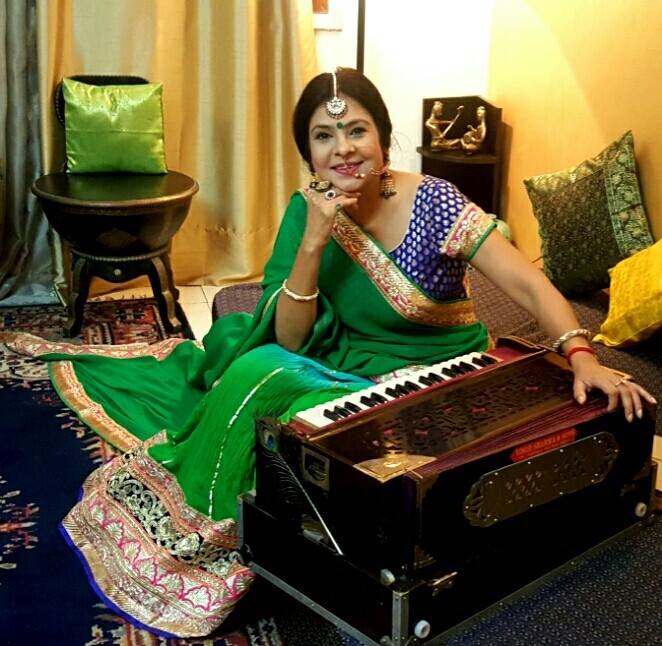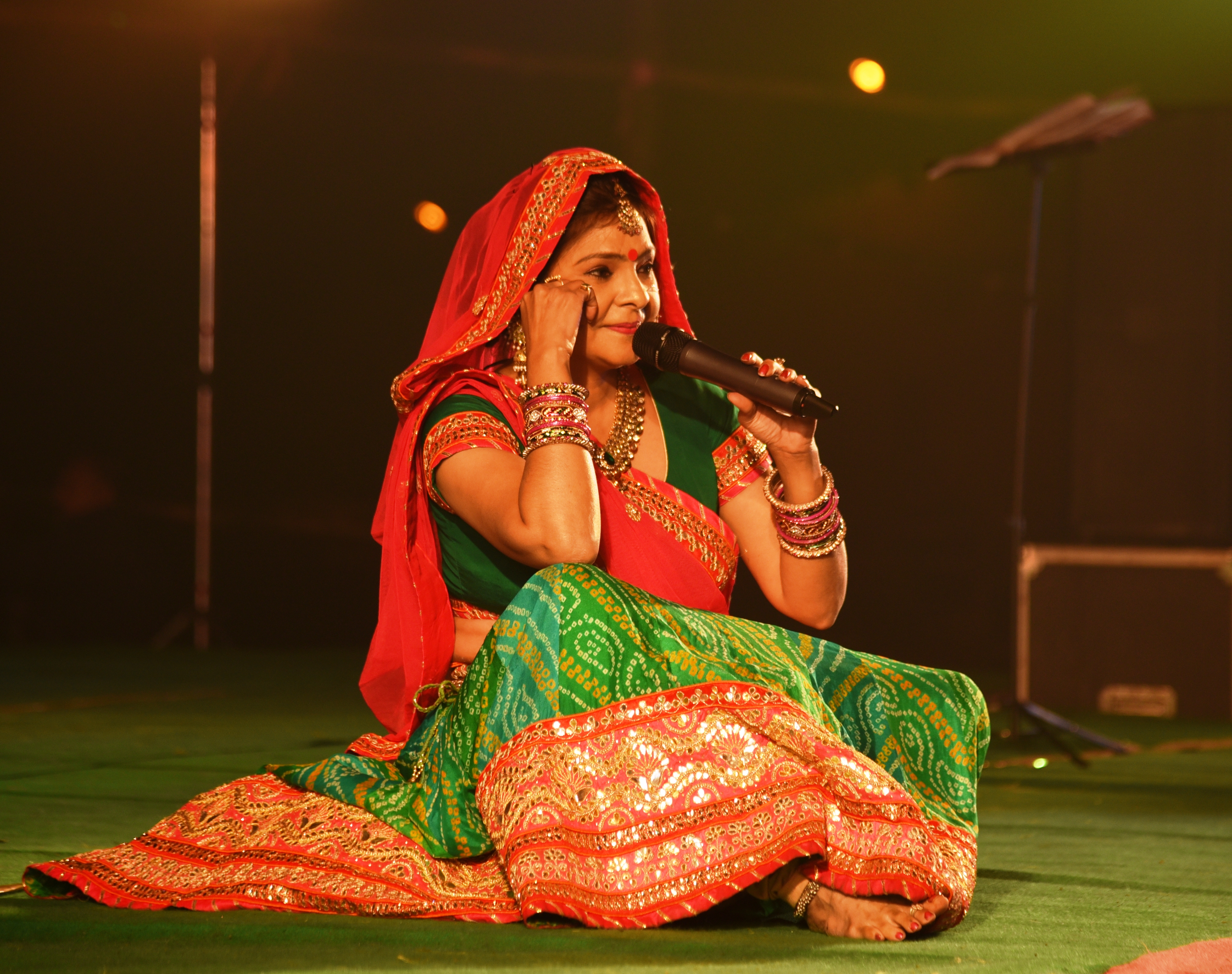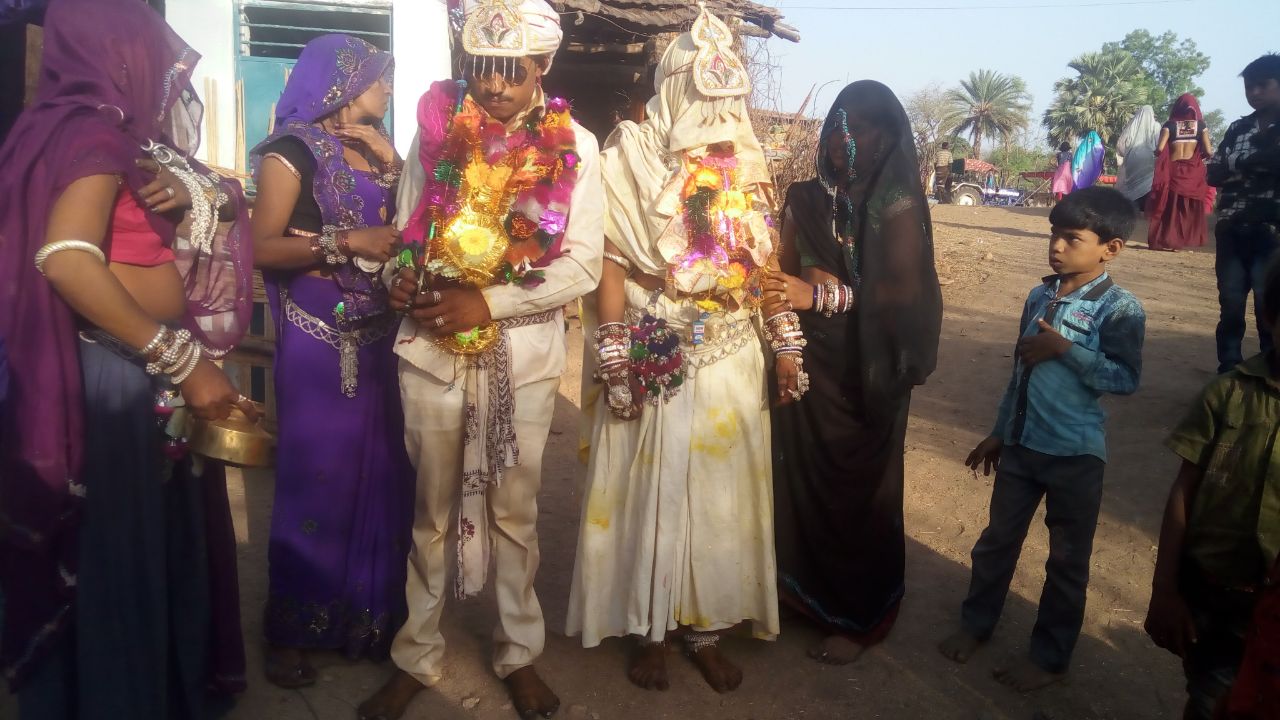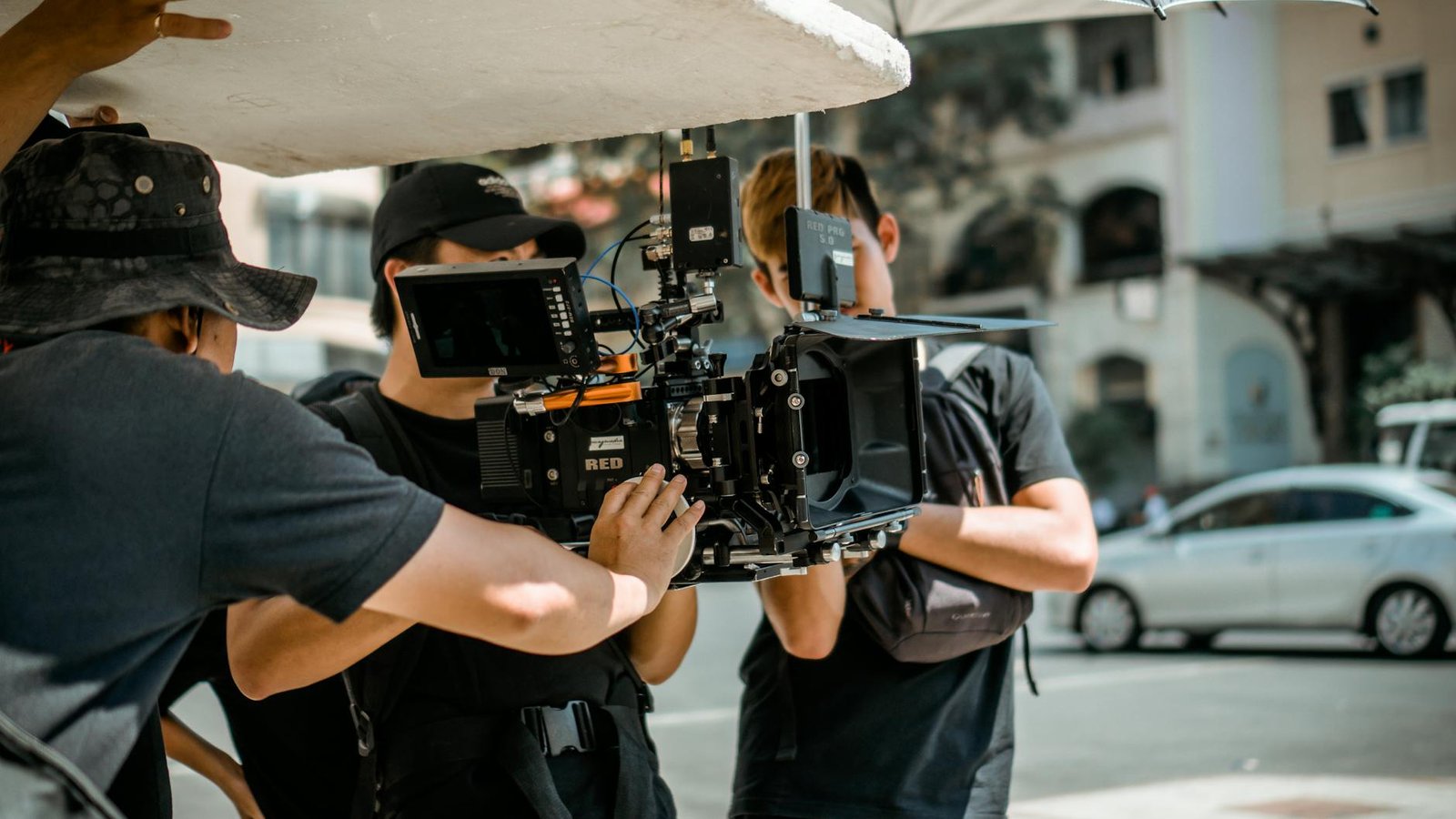Mirzapur, a city in the northern region of Uttar Pradesh, India, is renowned for its cultural legacy and festive spirit. The Kajari Festival, also known as Kajari Teej, is significant among its many celebrations. This festival is celebrated during Bhadrapada (August-September) and signifies the advent of the monsoon season.

The Kajari Festival pays homage to the Kajali, a traditional folk tune sung in the Bhojpuri area of India during the monsoon season. Kajali is a poetic form that conveys the sentiments and experiences of the farmers during this time. This particular thing is said to have originated in Mirzapur and has now spread throughout the Bhojpuri region.
Table of Contents
The festival is celebrated on the ninth day of the Krishna Paksha of Bhadrapada month, also known as Kajari Navami. On this day, women in Mirzapur and surrounding areas fast for the long life of their husbands and sing Kajali songs. They also make beautiful and intricate patterns known as Aalpana or rangoli with rice flour on the floors of their homes.
The festival is celebrated with great zeal and enthusiasm in Mirzapur. The entire city comes alive with music, dance, and cultural activities. The streets are decorated with colorful lights. Processions are taken out throughout the city, with women singing Kajali songs and dancing to their beats.

The Kajari Festival is known for its vibrant Kajari Mela, a three-day fair held within the city. The event is a lively celebration featuring traditional handicrafts, clothing, and food vendors. Additionally, cultural shows and contests take place, with rewards given to the winners.
Another critical aspect of the Kajari Festival is worshiping the Neem tree. The Neem tree is considered a sacred tree in Hinduism. During the Kajari Navami, women tie sacred threads around the Neem tree and offer prayers for the long life of their husbands.
The Kajari Festival is more than just a tribute to the monsoon season. It is also a commemoration of the vibrant cultural heritage of Mirzapur. This event brings the residents of Mirzapur together to honor their customs and traditions and impart them to the younger members of their community.
Histroy of Kajari or Kajali
Kajari has its roots in the medieval period. Still, it gained popularity in the 19th century through the musicians of the Benares Gharana. This style of Indian classical music also referred to as the Benares style, is recognized for its unique singing technique and has played a significant role in the evolution of Kajari.
Initially, Kajari was sung by women farmers in rural areas during the monsoon season to celebrate the arrival of rain and the harvest season. Over time, it became a popular music genre and gained popularity among the masses. Today, Kajari is a popular folk music genre widely performed and enjoyed during the monsoon season in various parts of India.
Origin of Kajari or Kajali
Kajari, alternatively referred to as Kajali, is a traditional music genre that originated in Uttar Pradesh and Bihar, India. The term ‘Kajari’ is derived from the Hindi word “Kajra,” which translates to “kohl.” This term symbolizes the dark clouds that bring the monsoon rainfall. Kajari songs are typically performed during the rainy season.
During the monsoon season, women traditionally sing Kajari in Shravana (August-September) to welcome the rains and pay homage to Devi Parvati, the Hindu goddess of wealth and prosperity. The songs are usually performed slowly, melodiously during the evening or at night, accompanied by the rhythmic beats of the dholak and other percussion instruments.
The lyrics of kajari songs are usually devotional and express a range of emotions, from joy and celebration to longing and melancholy. The pieces often depict the various aspects of rural life, such as farming, animal husbandry, and village customs and traditions. Many kajari songs also celebrate the beauty of nature and the joys and sorrows of human relationships.
As time passed, kajari became a significant aspect of the North Indian folk music traditions and has been modified to suit different regional styles and languages. The Kajari Festival held in Mirzapur is a remarkable event celebrating this diverse cultural heritage.
Kajari Singer
Kajari singers are talented individuals who specialize in performing the traditional folk music form known as Kajali. These singers possess a deep understanding of the nuances of Kajali music and are skilled in conveying the emotions and essence of the songs to their audience.
Kajari singers often undergo rigorous training to develop their vocal abilities and master the unique style and techniques associated with Kajali. They learn to modulate their voice, infuse the songs with expressions, and create a captivating atmosphere through their performances.
Malini Awasthi is known for her beautiful rendition of Kajari songs. She has released several albums of Kajari music, including “Kajri Lokgeet” and “Rang De Chunariya” Her soulful and melodic voice has made her a popular name in folk music. In her performances, she sings and shares exciting stories and information about the history and culture of Kajari.

Through her live performances and recordings, Malini Awasthi has brought Kajari music to a broader audience. She has performed at various music festivals in India and worldwide, including the prestigious Edinburgh Festival in Scotland. She has also collaborated with other musicians and artists to create unique and innovative versions of Kajari songs.

Through her music, Malini Awasthi has helped to preserve and promote the rich cultural heritage of Kajari. In addition, she has inspired a new generation of musicians and music lovers to appreciate this beautiful and unique style of folk music.
These singers play a crucial role in keeping the tradition of Kajali alive and vibrant. They are responsible for preserving the rich cultural heritage of Mirzapur and the surrounding regions where Kajari is celebrated. Through their renditions, they transport listeners to the world of Kajali, where the melodies evoke emotions and connect people to their roots.
Kajari singers perform at various occasions and events, including the Kajari Festival in Mirzapur. They enchant the audience with their soulful renditions of Kajali songs, capturing the essence of love, nature, and monsoon in their performances. Their melodious voices and the accompaniment of traditional musical instruments create a mesmerizing experience for the listeners.
Over the years, many Kajari singers have gained recognition for their exceptional talent and contribution to the music world. Their performances have garnered appreciation within their local communities and on national and international platforms, bringing Kajari to a broader audience and spreading its beauty beyond the boundaries of Mirzapur.
Kajari singers are an integral part of the cultural fabric of Mirzapur, and their dedication and passion for Kajali music ensure that this traditional folk art form continues to thrive and captivate generations to come.
Kajari Festival Beyond Mirzapur
While Mirzapur is renowned for its vibrant Kajari Festival, its influence and celebration of Kajari extend beyond the city’s boundaries. This traditional folk music form has gained recognition and popularity in various regions across Bihar and Uttar Pradesh, and other parts of India.
In Bihar, Kajari holds a special place in the cultural landscape. The festival is celebrated enthusiastically in cities like Patna, Bhagalpur, and Munger, where artists and music enthusiasts come together to pay tribute to Kajari. The melodious tunes and soulful lyrics of Kajari resonate with the people of Bihar, and the festival serves as a platform to showcase local talent and preserve the region’s cultural heritage.
Similarly, in Uttar Pradesh, Kajari is celebrated beyond Mirzapur. Cities such as Varanasi, Allahabad, and Lucknow embrace the festival, organizing cultural events, music performances, and competitions to promote and honor Kajari. These celebrations bring together artists, singers, and music lovers who appreciate the beauty and significance of this folk music form.
Furthermore, Kajari has transcended regional boundaries and found its way into the hearts of people across India. Folk music festivals and cultural events held in different parts of the country often include performances and renditions of Kajari. Renowned artists and Kajari singers from Mirzapur and other regions are invited to showcase their talent and spread the enchanting melodies of Kajari to a broader audience.
Additionally, with the advent of digital platforms and social media, Kajari has gained global exposure. People worldwide can now access and appreciate the beauty of Kajari music through online platforms, fostering a deeper understanding and appreciation of this traditional folk art form.
The celebration of Kajari beyond Mirzapur is a testament to its enduring charm and cultural significance. It showcases this musical genre’s widespread love and ability to resonate with people from diverse backgrounds. Kajari continues to captivate audiences far and wide, leaving an indelible mark on the cultural tapestry of Mirzapur, the entire region, and beyond.
The Kajari Festival’s Social Impact
The Kajari Festival in Mirzapur, with its vibrant celebrations and the enchanting melodies of Kajali, has a significant social impact on the local community and beyond. This cultural extravaganza brings people together, fosters a sense of unity, and contributes to the region’s social fabric in several ways.
- Cultural Preservation: The Kajari Festival plays a crucial role in preserving and promoting the rich cultural heritage of Mirzapur. It serves as a platform to showcase the traditional art form of Kajali and ensures its continuity for future generations. By celebrating and honoring Kajari, the festival helps preserve its unique folk music traditions and rituals.
- Community Engagement: The festival catalyzes community engagement and interaction. People from different backgrounds and communities come together to celebrate the Kajari Festival, transcending barriers of age, gender, and social status. It strengthens the sense of community and belonging among the residents of Mirzapur, fostering a spirit of togetherness.
- Economic Boost: The Kajari Festival attracts many tourists and visitors to Mirzapur. This influx of people contributes to the local economy by generating income for various businesses such as hotels, restaurants, handicraft vendors, and transportation services. The festival serves as a source of livelihood for many individuals and stimulates economic growth in the region.
- Tourism Promotion: Mirzapur’s Kajari Festival has gained recognition beyond the local community. It acts as a cultural magnet, attracting tourists from different parts of India and even abroad. The festival showcases the unique cultural identity of Mirzapur and serves as a compelling reason for travelers to visit the city. This, in turn, promotes tourism and exposes visitors to the diverse traditions and art forms of the region.
- Artistic Expression and Skill Development: The Kajari Festival provides a platform for local artists and performers to showcase their talent and hone their skills. It encourages artistic expression and nurtures creativity within the community. The festival serves as a stepping stone for budding artists, allowing them to gain exposure and recognition for their talent.
- Social Cohesion: Through the celebration of Kajari, the festival reinforces the bonds within the community. It creates an atmosphere of joy, celebration, and cultural pride, fostering a sense of unity and harmony among the residents of Mirzapur. The shared experience of music, dance, and festivities strengthens social ties and promotes a sense of collective identity.
In conclusion, the Kajari Festival in Mirzapur goes beyond being a mere cultural event. It has a profound social impact by preserving cultural heritage, fostering community engagement, boosting the local economy, promoting tourism, nurturing artistic talent, and fostering social cohesion. The festival serves as a testament to the transformative power of music and cultural celebrations in enriching the lives of individuals and communities.
Celebrations and Activities
The Kajari Festival in Mirzapur is a grand celebration filled with vibrant activities and joyful festivities. The festival spans several days and offers a range of events that engage and entertain both locals and visitors. Here are some of the key celebrations and activities that take place during the Kajari Festival:
- Musical Performances: The heart of the Kajari Festival lies in the mesmerizing musical performances. Renowned Kajari singers and artists take the stage to enchant the audience with their soulful renditions of Kajali songs. Their melodious voices, accompanied by traditional musical instruments, create an immersive experience, captivating the listeners with the rich melodies and emotive lyrics.
- Dance and Folk Performances: The festival also showcases captivating dance performances that complement the music of Kajari. Folk dancers adorned in vibrant traditional attire gracefully move to the rhythm of the music, adding a visual spectacle to the celebrations. These performances often depict stories and legends associated with Kajari and showcase the cultural heritage of Mirzapur.
- Rituals and Traditions: The Kajari Festival incorporates various rituals and traditions that are deeply rooted in the local culture. A common ritual is the offering of “Kajari Teej,” where women prepare special delicacies and offer them to deities, seeking blessings for a prosperous monsoon and a bountiful harvest. These rituals add a spiritual dimension to the festival and highlight the cultural significance of Kajari.
- Cultural Competitions: The Kajari Festival provides a platform for local artists, singers, and performers to showcase their talent through cultural competitions. Participants compete in categories such as singing, dancing, poetry recitation, and traditional art forms. These competitions not only celebrate the rich artistic heritage of Mirzapur but also encourage the development of talent within the community.
- Art and Craft Exhibitions: The festival often features exhibitions showcasing the vibrant art and craft traditions of Mirzapur and the surrounding regions. Visitors can explore stalls filled with beautiful handicrafts, pottery, paintings, and other artistic creations. These exhibitions not only promote the local artisans but also provide an opportunity for visitors to appreciate and purchase unique handmade products.
- Food and Cuisine: The Kajari Festival is also a culinary delight, offering a wide array of traditional delicacies and local cuisine. Food stalls and vendors line the festival grounds, serving mouthwatering dishes that tantalize the taste buds. Visitors can savor regional specialties, street food, and traditional sweets, adding a gastronomic experience to the festivities.
- Cultural Workshops and Demonstrations: The Kajari Festival often organizes workshops and demonstrations to promote traditional arts and crafts. These interactive sessions allow participants to learn various skills such as folk painting, pottery making, and traditional instrument playing. These workshops aim to preserve and pass on the traditional knowledge and craftsmanship to future generations.
The celebrations and activities during the Kajari Festival create an immersive and engaging experience for everyone involved. They showcase the rich cultural heritage of Mirzapur, promote artistic expressions, and foster a sense of community pride and joy. The festival truly comes alive with the amalgamation of music, dance, rituals, art, and gastronomy, making it a memorable and cherished event for all attendees.
To sum up, the Kajari Festival holds an important place in the cultural identity of Mirzapur. It commemorates the arrival of the monsoon season, honors the city’s cultural heritage, and embodies the lively spirit of its people. This celebration seamlessly merges tradition with modernity and serves as a unifying event that brings people together to revel in their diverse and vibrant culture.
Biraha
Apart from Kajari, Mirzapur is known for Biraha, Chaita, Belwariya, Faag, and other forms of folk culture. One of Mirzapur’s most popular forms of folk culture is Biraha, a form of poetry sung in the local dialect. Biraha is a type of music that originated in the region and is performed during festivals and other cultural events.
The Biraha is a lyrical composition that tells the story of love and separation. It is a form of poetry sung by the Biraha singers, primarily men. The singers use traditional instruments like the harmonium and the tabla to create a soothing and uplifting rhythm.

Biraha has been a part of Mirzapur’s cultural heritage for many years. The local people have preserved this music form and passed it down from one generation to another. The songs are sung in a slow and melodic tone, and the lyrics are filled with emotions and sentiments that touch the hearts of the listeners.
History of Biraha
The history of Biraha can be traced back to the medieval period when various kingdoms, including the Mughals, the Marathas, and the British, ruled the Bhojpuri region. During this time, Biraha songs were used as a means of entertainment and as a way of expressing the pain of separation from loved ones. As a result, the genre gained popularity in the 18th and 19th centuries. It was later adapted into various regional languages, including Maithili, Magahi, and Awadhi.
Male singers usually sing Biraha songs, accompanied by a dholak (a double-headed drum) and a flute. The songs are often very emotional, and they can be pretty sad. They express the pain of separation and the longing for the beloved. Biraha songs are usually performed at weddings and other social gatherings. They are also used to express grief and sorrow at funerals.

One of the unique features of Biraha songs is their use of dialects and idioms specific to the Bhojpuri region. These dialects and idioms add a distinct flavor to the songs, making them more relatable to the local audience. Biraha songs also have a rich oral tradition, with many singers passing on the songs from generation to generation.
Biraha songs have been popularized through various mediums, including films, radio, and television. Many popular Bhojpuri films feature Biraha songs, which have helped to keep the genre alive and relevant in modern times. The popularity of Biraha songs has also led to the development of various sub-genres, including the “Biraha Geet,” which is a form of Biraha sung by women.
Biraha is an essential part of the Bhojpuri culture. It is a way for people to express their emotions and connect. Moreover, the songs are a reminder of the power of love and the pain of separation. Therefore, they are a valuable part of the Bhojpuri heritage.
Here are some examples of Biraha songs:
- “Aaj Birha Ke Din Hai” (This is the day of separation)
- “Pyar Ke Dard Se Maar Gayi” (the pain of love has killed me)
- “Bina Pyaar Ke Jeena Nahin” (I cannot live without love)
- “Dil Tod Ke Gaye Ho” (You have broken my heart)
- “Abhi Toh Aaye Hain Chale Gaye” (You have just come and gone)
These are just a few Biraha songs sung over the years. They are a testament to the power of love and the pain of separation. Hence, they are a valuable part of the Bhojpuri heritage.
Here is a list of some of the most famous Biraha singers:
- Bihari Lal Yadav
- Baleshwar Yadav
- Heera Lal Yadav
- Dinesh Lal Yadav, ‘Nirhua’
- Sharda Sinha
- Kalpana Patowary
- Indrajeet Yadav
- Pawan Singh
- Vijay Lal Yadav
- Umesh Mishra
These singers are all known for their powerful voices and their ability to convey the emotions of separation and longing. Their songs are often performed at weddings and other social gatherings and are used to express grief and sorrow at funerals.

Biraha has gained international recognition recently, with many music festivals and cultural events featuring Biraha performances. Musicologists and anthropologists have also studied the genre and have recognized its cultural and historical significance.
In conclusion, Biraha is a vibrant folk song genre that has played an essential role in the cultural history of the Bhojpuri region. Its soulful melodies and poignant lyrics continue to resonate with audiences today, making it a timeless form of musical expression.
Future of Folk Music
The future of folk music in Mirzapur is uncertain, but there are still some positive signs for its survival and growth. Despite the popularity of mainstream music, many people in Mirzapur still appreciate and enjoy folk music. There are also efforts by various organizations and individuals to promote and preserve folk music.
One positive sign is the increasing popularity of folk music festivals in Mirzapur. These festivals provide a platform for folk musicians to showcase their talents and connect with audiences. They also help to raise awareness about the importance of preserving folk music.
Another factor that could contribute to the future of folk music in Mirzapur is the growing interest in traditional culture and heritage. As people become more aware of the value of their cultural heritage, they may be more likely to seek out and appreciate traditional folk music.

However, there are also challenges to the survival of folk music in Mirzapur. One major challenge is the need for more support for folk musicians, both financially and socially. As a result, many folk musicians struggle to make a living from their music. They may need to receive the recognition and respect they deserve from society.
Another challenge is the influence of mainstream music, which can overshadow and diminish the importance of folk music. The dominance of commercial music and the focus on profit may also make it more difficult for folk musicians to gain visibility and support.
Here are some of the things that can be done to ensure the future of folk music in Mirzapur:
- Promote folk music education in schools and colleges.
- Organize folk music festivals and competitions.
- Support folk music artists and ensembles.
- Create opportunities for folk musicians to perform in public.
- Document folk music traditions and songs.
- Digitize folk music archives.
- Support research on folk music.
- Raise awareness of the importance of folk music.
By taking these steps, we can help ensure folk music thrives in Mirzapur for many years.
Some of the steps that can be taken to ensure the future of folk music in Mirzapur include:
- It promotes folk music education in schools and colleges. This will help to introduce folk music to a new generation of listeners and performers.
- They are organizing folk music festivals and competitions. This will help to create a platform for folk musicians to showcase their talents and connect with audiences.
- It supports folk music artists and ensembles. This can be done by providing financial assistance, rehearsal space, and other resources.
- They are creating opportunities for folk musicians to perform in public. This can be done by booking them at schools, festivals, and other events.
- Documenting folk music traditions and songs. This will help to preserve these traditions for future generations.
- Digitizing folk music archives. This will make folk music more accessible to a broader audience.
- Supporting research on folk music. This will help better to understand the history and significance of folk music.
- Raising awareness of the importance of folk music. This can be done through public education campaigns, social media, and other means.
By taking these steps, we can help ensure that folk music continues to thrive in Mirzapur for many years.
Overall, the future of folk music in Mirzapur is still being determined. However, there are still opportunities for its growth and preservation. It will require the support of individuals, organizations, and society to ensure that Mirzapur’s rich folk music tradition continues to thrive.
Mirzapur’s Kajari Festival is a testament to the rich cultural heritage and musical traditions of the region. The celebration of Kajali brings together people of all ages and backgrounds, uniting them through the enchanting melodies and expressive lyrics. The festival not only preserves the traditional art form but also fosters community spirit and promotes tourism. Mirzapur’s Kajari Festival truly stands as a tribute to the melodious Kajali.
When does the Kajari Festival take place in Mirzapur?
The Kajari Festival in Mirzapur usually takes place during August, marking the arrival of the monsoon season.
What is the significance of Kajari in Mirzapur?
Kajari holds tremendous cultural and historical significance in Mirzapur. It is a folk music form that originated in the region and is celebrated during the Kajari Festival to pay homage to this musical tradition.
Can anyone participate in the Kajari Festival in Mirzapur?
Yes, the Kajari Festival in Mirzapur is open to all. People from different backgrounds and communities come together to celebrate and enjoy the enchanting melodies of Kajali.
Are there any other festivals celebrated in Mirzapur apart from the Kajari Festival?
Yes, Mirzapur is known for its rich cultural tapestry and hosts several other festivals throughout the year, including the Vindhyavasini Mela and the Chunar Mahotsav.
Where can I experience the Kajari Festival in Mirzapur?
To experience the vibrant celebrations of the Kajari Festival in Mirzapur, you can visit various locations in the city, including riversides, community centers, and cultural venues where performances and activities are organized.
In conclusion, the Kajari Festival in Mirzapur is a mesmerizing celebration that showcases the beauty of Kajali, a lyrical folk music form. The festival brings together people from all walks of life to rejoice in the enchanting tunes, rituals, and traditions associated with Kajali. Mirzapur’s Kajari Festival serves as a vibrant tribute to the region’s rich cultural heritage and musical legacy.







